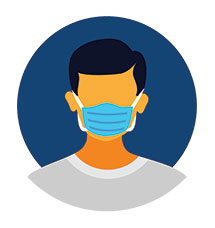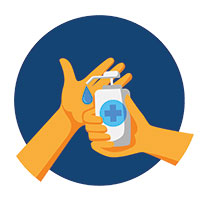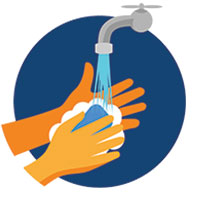Epidemic & Pandemic Preparedness
Illness and disease are part of our everyday life. Once the transmission of a disease reaches abnormal and growing proportions it is termed and epidemic. A pandemic is a multi-epidemic event across more than one county affecting large groups of people.
- While no one can be 100% safe from disease transmission, everyone can employ a number of strategies to help keep them at lower risk.
- Make these strategies part of your daily routines and practices.
How to reduce your risk
 Many diseases have specific symptoms and ways they can be spread through a population. Your health professional, the CDC, and WHO will have disease specific tips and advice should an outbreak occur.
Many diseases have specific symptoms and ways they can be spread through a population. Your health professional, the CDC, and WHO will have disease specific tips and advice should an outbreak occur.
To limit your exposure to germs in general, the CDC suggest you always consider:
- Avoid close contact with people who are sick.
- Stay home when you are sick.
- Avoid touching your eyes, nose, and mouth.
- Cover your cough or sneeze with a tissue, then throw the tissue in the trash.
 Clean and disinfect frequently touched objects and surfaces using a regular household cleaning spray or wipe. This includes door knobs, switches, handles, etc.
Clean and disinfect frequently touched objects and surfaces using a regular household cleaning spray or wipe. This includes door knobs, switches, handles, etc.- Follow CDC’s recommendations for using face coverings.
- Wear a face covering in public settings and when around people who don’t live in your household, especially when other social distancing measures are difficult to maintain.
- Masks should NOT be worn by children under the age of 2 or anyone who has trouble breathing, is unconscious, incapacitated, or otherwise unable to remove the mask without assistance.
- Masks with exhalation valves or vents should NOT be worn to help prevent the person wearing the mask from spreading COVID-19 to others (source control).
 Wash your hands often with soap and water for at least 20 seconds, especially after going to the bathroom; before eating; and after blowing your nose, coughing, or sneezing.
Wash your hands often with soap and water for at least 20 seconds, especially after going to the bathroom; before eating; and after blowing your nose, coughing, or sneezing.
- If soap and water are not readily available, use an alcohol-based hand sanitizer with at least 60% alcohol. Always wash hands with soap and water if hands are visibly dirty.
- Stay away from crowded venues when there is an outbreak of flu or other illness in your community
- Consider both a flu and pneumonia vaccinations annually. While they may not protect against some disease decreasing the number of ill people (flu vaccine) and working to limit secondary infections (pneumonia Vaccine) can take pressure of the medical community and reduce your own illness experience.
For information about handwashing, see CDC’s Handwashing website
For information specific to healthcare, see CDC’s Hand Hygiene in Healthcare Settings
Planning for Pet Support
Here are some useful tips from Sonoma County Animal Services intended to help you prepare in case your pets need to be cared for by someone else during these uncertain times. Planning ahead will ease your mind if you suddenly, or on short notice, need extra help or are not present to care for them.
Three Tips
 Make sure you have up-to-date contact information for neighbors, friends and/or family members who can care for animals.
Make sure you have up-to-date contact information for neighbors, friends and/or family members who can care for animals.- Make a list for each animal and have this information handy and easily accessible, for example put it in a visible location, such as on your fridge.
- Approximate age and any known health issues
- For their food, note the brand/type, quantities, number of feedings and approximate time(s) of feeding per day.
- Information about pet medications, prescriptions, and flea/tick control, etc.
- Veterinary information including rabies vaccinations, medical paperwork, etc.
- As a best practice, be sure that your pet’s microchip is up-to-date (with your current cell phone number and email address) and that your animal’s collar has proper ID tags, (if you don’t have tags, use a permanent marker to write your phone number on the collar). This will also help your neighbors get your pet back to you in the event they go missing, and will prevent them from having to enter the shelter.
Looking back, past Pandemics include:
- 1918 H1N1 (commonly Spanish Flu) – It is estimated that about 500 million people or one-third of the world’s population became infected with this virus.
- 1957-1958 H2N2 (commonly Asian Flu) – The estimated number of deaths was 1.1 million worldwide and 116,000 in the United States.
- 1968 H3N2 (commonly Hong Kong Flu) –The estimated number of deaths was 1 million worldwide and about 100,000 in the United States. Most excess deaths were in people 65 years and older. The H3N2 virus continues to circulate worldwide as a seasonal influenza A virus.
- 2009 H1N1pdm09 (commonly Swine Flu) – From April 12, 2009 to April 10, 2010, CDC estimated there were 60.8 million cases (range: 43.3-89.3 million), 274,304 hospitalizations (range: 195,086-402,719), and 12,469 deaths (range: 8868-18,306) in the United States due to the (H1N1)pdm09 virus.
No two pandemics are alike so individual incidents will always carry incident specific advice.
Having Emergency Preparedness Kits at home provide many things you may need if an outbreak occurs in your community. This includes food so you can avoid going to the crowded stores and extra medication to allow you to avoid pharmacies. See Get Ready for information on being prepared in your home for anything!
